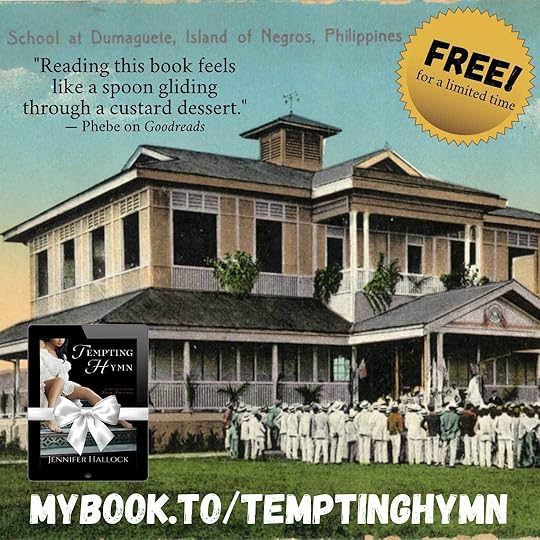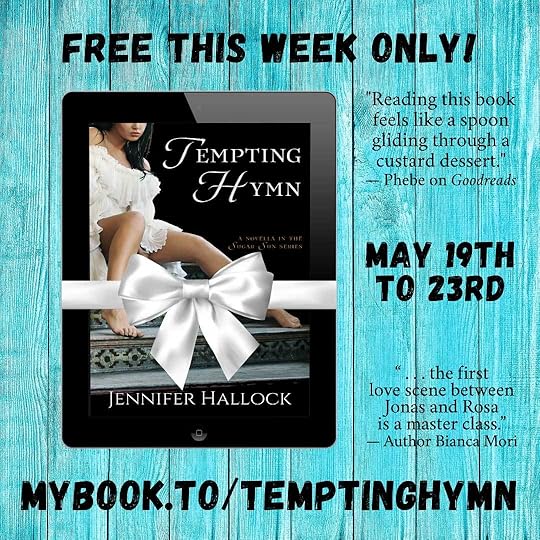Jennifer Hallock's Blog: Sugar Sun Series Extras, page 4
September 6, 2020
Tempting Hymn is Free!
I’ve made Tempting Hymn completely free on Amazon! Giveaway lasts from September 6th to the 10th only.
Jonas Vanderburg needs Rosa Ramos’s help to rebuild both his health and his life. But Rosa is scared to pin her future on the promises of yet another American. Leaving hospital together is not the biggest challenge for these two people from different faiths, countries, and generations: the missionary mafia that controls colonial Philippine society may never bless their union.
This is a steamy, historical, and cross-cultural marriage-of-convenience novella. If you like strong-but-silent blue-collar heroes and clever nurse heroines, this is the book for you. Full content guidance can be found here.
Praise for Tempting Hymn, a novella in the Sugar Sun series:
A- and Desert Isle Keeper from All About Romance: “If you like underrepresented settings, social class conflict, intercultural romance, working class characters, or just damn good historicals, the Sugar Sun series is one to get into. I’m certainly developing a sweet tooth!”
“Reading this book feels like a spoon gliding through a custard dessert.” (Phebe on Goodreads)
“I told myself I would go to bed early, but then I opened Tempting Hymn.” (Amazon Reviewer)
“Tempting Hymn manages to give adequate breathing room to the harsh historical realities of American colonial rule in the Philippines, while delivering a romance that is sweet, realistic and—above all—emotional. . . . Hallock doesn’t pull any punches in Tempting Hymn, with either the romance or the historical detail. She does her setting and her characters justice, delivering a story that is raw and unflinching, but never too dark, because it has an engaging and touching romance at its core. [And] all the sex scenes here are insanely hot, just like in Under a Sugar Sun.” (Dani St. Clair, Romancing the Social Sciences)
“This novella does a hell of a lot of work between the lines. It’s actually breathtaking.” (Kat at BookThingo, posted on Twitter)
“The pairing here is American man/Filipino woman and that is a tricky, sensitive trope…but it’s handled with deft and care. And dignity.” (Mina V. Esguerra, author of Iris After the Incident, reviewed on Facebook)
“…the first love scene between Jonas and Rosa is a master class.” (Bianca Mori, author of the Takedown trilogy, reviewed on Goodreads)
September 2, 2020
Who Saved Roosevelt’s Hide
This is the story you may have heard: Theodore Roosevelt built the second half of his national political career on his reputation as a hero from the Cuban theater of the Spanish-American War. As a lieutenant colonel with the 1st US Volunteer Cavalry Regiment, also known as the “Rough Riders,” Roosevelt promoted his own efforts in the fight to liberate Santiago, Cuba. His friend, Colonel Leonard Wood, helped create the legend by reporting to the War Department, “I have the honor to recommend Lieut. Col. Theodore Roosevelt . . . for a Medal of Honor for distinguished gallantry in leading a charge on one of the entrenched hills to the east of the Spanish position in the suburbs of Santiago de Cuba, July First, 1898.” (Yockelson 1998, 3)
This is the part you probably don’t know: Wood was not at the battle, and those who were there would tell a different story: Roosevelt and his Rough Riders owed their victory and probably their reputations to the African American regiments who saved their hides. These were the same troops Roosevelt would later disparage and, in some cases, dishonorably discharge by executive order.
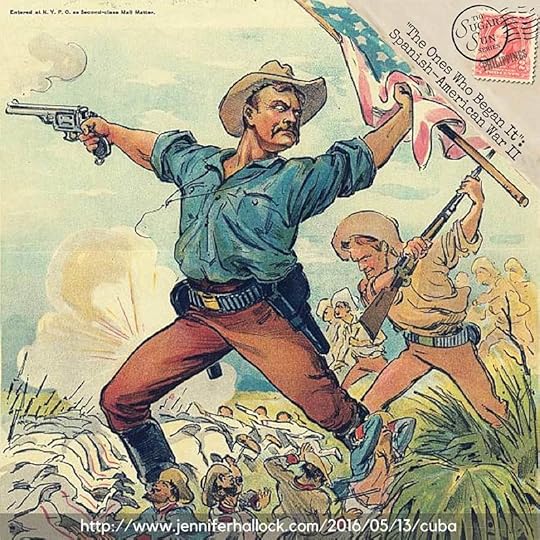 Navy accidents, fake news, and a New Yorker bent on war. I mean the Spanish-American War of 1898. What were you thinking? Find out more.
Navy accidents, fake news, and a New Yorker bent on war. I mean the Spanish-American War of 1898. What were you thinking? Find out more.Mr. Charles McKinley Saltzman, a white graduate of West Point and a veteran of the Cuba campaign, praised the 9th and 10th Cavalries, along with the 24th Infantry, for charging San Juan Hill in the most integrated battle of the war. He said that these African American soldiers “did much to save the Rough Riders from being cut to pieces.” (“Compliment to Colored Soldiers,” 1) The 24th Infantry “bore the brunt” of the fighting—and though they were specifically targeted by the Spanish, they stood their ground and performed challenging maneuvers “under the hottest fire of the day.” (“Colored Troops Win Praise from the White Press,” 2)
A reporter from New York said that the 10th Cavalry advanced, “firing as they marched, their aim was splendid. Their coolness was superb and their courage aroused admiration of their comrades.” (New York State Division) First Lieutenant John “Black Jack” Pershing—a hero who would fight in the Philippines and eventually become the American commander in Europe during World War I—also agreed that the 10th Cavalry saved Roosevelt’s forces. Rough Rider Frank Knox himself called the 10th Cavalry “the bravest men he had ever seen.” (New York State Division) A white corporal, who would also admit to his prejudice against Black Americans in general, was quoted saying: “If it had not been for the Negro Cavalry, the Rough Riders would have been exterminated.” (“Gov. Tanner’s Speech,” 4)
 Formation of African American soldiers whose unit is not identified. Accessed at the Library of Congress.
Formation of African American soldiers whose unit is not identified. Accessed at the Library of Congress.The Richmond Planet, an African American community newspaper, forecasted that though these soldiers had been “a right useful ‘article’ when white troops are in a tight place,” (“Gov. Tanner’s Speech,” 4) they would not be properly recognized. That is not entirely true. A few were: five members of the 10th Cavalry received the Congressional Medal of Honor, America’s highest and most-prestigious personal military decoration, as did a Black naval fireman on the USS Iowa off the coast of Cuba. Twenty-five other soldiers from African American units were awarded the Certificate of Merit, the second highest award at the time. (New York State Division) But those who did not survive Cuba did not receive their due posthumously. In fact, they were not even brought home to be buried like the fallen Rough Riders and other white officers. Instead, after suffering a 20% casualty rate (New York State Division), the African Americans killed in combat were buried in unmarked graves on the San Juan Heights near where they fell. (“President McKinley and the Negro Soldiers,” 1)
 “Dress on the Colors” by Dale Gallon. Acting Color Sergeant George Berry of Troop G, 10th US Cavalry Regiment carries the national flag of his own command as well as the standard of the 3rd US Cavalry Regiment in the assault upon the Spanish works at Kettle Hill, San Juan Heights, Cuba, July 1, 1898. Original commissioned by US Army War College, Carlisle, PA.
“Dress on the Colors” by Dale Gallon. Acting Color Sergeant George Berry of Troop G, 10th US Cavalry Regiment carries the national flag of his own command as well as the standard of the 3rd US Cavalry Regiment in the assault upon the Spanish works at Kettle Hill, San Juan Heights, Cuba, July 1, 1898. Original commissioned by US Army War College, Carlisle, PA.How did Roosevelt get the credit? He had “friends in the newspaper business [who] ensured that his exploits in Cuba were not overlooked by the public” (Yockelson 1998, 1) And it did make a good story: the rising star of the Republican Party had overcome debilitating asthma in his youth to become a college athlete, a successful rancher, and New York City Police Commissioner. Then he resigned his desk job as the Assistant Secretary of the Navy to endanger himself in battle. At least those parts of the story are true. The rest is not:
Roosevelt gives the impression that he alone was the first to charge the San Juan Heights to drive away the entrenched Spaniards. This image of Theodore Roosevelt was propagated with the help of Richard Harding Davis. Reporting for the New York Herald, Davis transcribed what Roosevelt told him, then added his own twist to the story. In addition to the newspaper articles, magazines and books picked up his story. Davis depicted a fearless Roosevelt, wearing a blue polka-dotted bandanna, charging up the hill mounted on his horse, Texas. Thus the legend of Theodore Roosevelt was created. (Yockelson 1998, 2)
As he continued to recount his exploits, the tales grew taller and taller. (Yockelson 1998, 2) Eventually, reflecting satisfactorily on his own bravery, Roosevelt wrote: “I am entitled to the Medal of Honor and I want it.” (Yockelson 1998, 1) Four months later, he “painfully told [Senator Henry Cabot] Lodge on December 6 that ‘if I didn’t earn it, then no commissioned officer can ever earn it.’” (Yockelson 1998, 3) When faced with the lack of direct eyewitnesses to prove his valor, Roosevelt claimed that was because he was so far out ahead of his fellow soldiers: “I don’t know who saw me throughout the fight, because I was almost always in the front and could not tell who was close behind me, and was paying no attention to it.” (Yockelson 1998, 4) His entitlement reached a fevered pitch when he wrote Senator Lodge: “I don’t ask this as a favor—I ask it as a right . . . If [the president and the War Department] want fighting [over it], they shall have it.” (Yockelson 1998, 3)
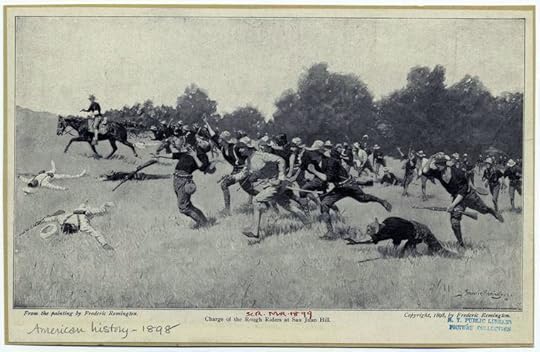 Charge of the Rough Riders at San Juan Hill by Frederic Remington. Accessed at the New York Public Library.
Charge of the Rough Riders at San Juan Hill by Frederic Remington. Accessed at the New York Public Library.Twenty-six other soldiers did earn the Congressional Medal of Honor in the fight for Santiago, Cuba, including the five Black cavalrymen of the 10th and the one sailor mentioned above, but Roosevelt did not receive the citation in his lifetime. (Yockelson 1998, 4) He did not lose well, especially not to the African American soldiers that the War Department recognized:
In a series of articles published in Scribner’s Magazine [Roosevelt] contended that the physical ability of African-Americans to perform on the battlefield was only useful if guided by the paternal supervision of white officers. He even claimed that African-American soldiers had an inordinate tendency to retreat and engage in “misconduct” when white officers were not present. . . . [This behavior was] “natural in those but one generation from slavery and but a few generations removed from the wildest savagery.” (Ngozi-Brown 1997, 44)
In another article, Roosevelt wrote that Black soldiers were “particularly dependent upon their white officers. Occasionally they produce non-commissioned officers who can take the initiative and accept responsibility precisely like the best class of whites; but this can not be expected normally, nor is it fair to expect it.” (Amron 2012, 414-15) He even claimed that the African American soldiers lagged back in the rear, some fleeing the battlefield, until Roosevelt himself prompted them forward at revolver-point. (Amron 2012, 415; New York State Division) “According to Presley Holliday, a former Sergeant in the 10th Cavalry, Roosevelt actually stopped four soldiers on their way to pick up ammunition from a supply point”—not retreating at all, in fact. The four soldiers were doing their job. (New York State Division)
 Roosevelt’s serialized war memoirs in Scribner’s, courtesy of Streets of Salem.
Roosevelt’s serialized war memoirs in Scribner’s, courtesy of Streets of Salem.How did the United States War Department see fit to reject Roosevelt’s lobbying for an award and instead bestow the same upon a handful on the soldiers he disparaged? Could they have been swayed by other press outlets? J. N. Johnson, a prominent African American doctor and attorney, wrote to the Washington Post:
. . . I write to thank the press, including The Post, in the name of the whole race, for favorable mention of the black soldiers who played their part so well, though having no opportunity for official recognition of their conspicuous bravery. . . . The negro soldier was needed; he was on hand and played his part well; and though the government is silent the press sings his praise. (“Negro Soldiers Bravery” 1898)
 24th Infantry Leaving Salt Lake City, Utah, for Chattanooga, Tennessee, April 24th, 1898. Accessed at the Library of Congress.
24th Infantry Leaving Salt Lake City, Utah, for Chattanooga, Tennessee, April 24th, 1898. Accessed at the Library of Congress.Unfortunately, according to antiracism expert Ibram X. Kendi in his book Stamped from the Beginning: The Definitive History of Racist Ideas in America, the recognition of these Black war heroes did little to halt the spread of racist ideas. “While ‘negative’ portrayals of Black people often reinforced racist ideas, ‘positive’ portrayals did not necessarily weaken racist ideas. The ‘positive’ portrayals could be dismissed as extraordinary Negroes, and the ‘negative’ portrayals could be generalized as typical.” (2017, 328) Bravery, patriotism, and valor would not end discrimination. In fact, the crimes of the Jim Crow period—including disenfranchisement, convict leasing, and lynchings—would only accelerate.
 Portraits of 15 African American soldiers and sailors who received Medals of Honor for service in the American Civil War, American Indian Wars, and Spanish American War from W. E. B. Du Bois, accessed at the Library of Congress.
Portraits of 15 African American soldiers and sailors who received Medals of Honor for service in the American Civil War, American Indian Wars, and Spanish American War from W. E. B. Du Bois, accessed at the Library of Congress.How bitter would Roosevelt be? On the one hand, in 1901 he was the first president to invite an African American to join his family for supper at the President’s House. But the straightforward invitation to prominent educator Booker T. Washington set off a firestorm. South Carolina senator said that it would take the lynchings of a thousand Black people “before they will learn their place again.” (Kendi 2017, 290) Roosevelt promised to never repeat his mistake, and to be sure he officially renamed the residence the White House. (Kendi 2017, 290) He would also single-handedly tear apart the careers and eliminate the pensions of 167 Black veterans—the entire 25th Infantry battalion—after blaming them for a riot in Brownsville, Texas, despite clear evidence to the contrary. Six of these men had won the Congressional Medal of Honor, and thirteen had received the Certificate of Merit, the next highest award. 123 of the 167 had served in the US Army for over five years, which means combat in the Philippines, and 26 of them had served for over ten years, which means combat in Cuba too. One career soldier had spent 24 years in the Army. All of them lost their entire retirement investment by executive order, without even the decency of a court-martial. (“Troops Not Spared” 1906, 1)
 Booker T. Washington at the White House from “The Secret Life of Booker T. Washington.”
Booker T. Washington at the White House from “The Secret Life of Booker T. Washington.”Eventually Teddy Roosevelt got what he wanted—in 2001, more than eight decades after his death. During the waning days of the Clinton Administration, the U.S. Department of Defense bestowed a posthumous Congressional Medal of Honor upon Theodore Roosevelt. His media machine finally won.
[Featured image is a vintage postcard of the 25th Infantry at Basilan in the Sulu Archipelago.]
Bibliography:
Amron, Andrew D. “Reinforcing Manliness: Black State Militias, the Spanish-American War, and the Image of the African-American Soldier, 1891-1900.” The Journal of African American History 97, no. 4 (2012): 401-26. https://doi.org/10.5323/jafriamerhist.97.4.0401.
“Colored Troops Win Praise from the White Press.” Richmond Planet. (Richmond, Va.), 23 July 1898. Chronicling America: Historic American Newspapers. Lib. of Congress. https://chroniclingamerica.loc.gov/lccn/sn84025841/1898-07-23/ed-1/seq-2/.
“Compliment to Colored Soldiers.” Iowa State Bystander. (Des Moines, Iowa), 29 July 1898. Chronicling America: Historic American Newspapers. Lib. of Congress. https://chroniclingamerica.loc.gov/lccn/sn83025186/1898-07-29/ed-1/seq-1/.
“Gov. Tanner’s Speech.” Richmond Planet. (Richmond, Va.), 23 July 1898. Chronicling America: Historic American Newspapers. Lib. of Congress. https://chroniclingamerica.loc.gov/lccn/sn84025841/1898-07-23/ed-1/seq-4/.
Johnson, J. N. “Negro Soldiers’ Bravery: How Can They Be Utilized in Our New Territory.” The Washington Post (1877-1922), Jul 13, 1898. https://search.proquest.com/docview/143949611?accountid=11220.
Kendi, Ibram X. Stamped from the Beginning: The Definitive History of Racist Ideas in America. New York: Bold Type Books, 2017. Kindle edition.
New York State Division of Military and Naval Affairs. “Black Americans in the US Military from the American Revolution to the Korean War: The Spanish American War and the Philippine Insurgency.” New York State Military History Museum and Veterans Research Center. Last modified March 30, 2006. Accessed June 29, 2020. https://dmna.ny.gov/historic/articles/blacksMilitary/BlacksMilitaryContents.htm.
Ngozi-Brown, Scot. “African-American Soldiers and Filipinos: Racial Imperialism, Jim Crow and Social Relations.” The Journal of Negro History 82, no. 1 (1997): 42-53. https://doi.org/10.2307/2717495.
“President McKinley and the Negro Soldiers.” The Broad Ax. (Salt Lake City, Utah), 22 July 1899. Chronicling America: Historic American Newspapers. Lib. of Congress. https://chroniclingamerica.loc.gov/lccn/sn84024055/1899-07-22/ed-1/seq-1/.
“Troops Not Spared.” The Washington Post (1877-1922), Nov 22, 1906. https://search.proquest.com/docview/144648836?accountid=11220.
Yockelson, Mitchell. “‘I Am Entitled to the Medal of Honor and I Want It’: Theodore Roosevelt and His Quest for Glory.” Prologue, Spring 1998. Accessed July 30, 2020. https://www.archives.gov/publications/prologue/1998/spring/roosevelt-and-medal-of-honor-1.html.
How the 9th & 10th Cavalry Saved Roosevelt’s Hide
This is the story you may have heard: Theodore Roosevelt built the second half of his national political career on his reputation as a hero from the Cuban theater of the Spanish-American War. As a lieutenant colonel with the 1st US Volunteer Cavalry Regiment, the “Rough Riders,” Roosevelt promoted his own efforts in the fight to liberate Santiago, Cuba. Fellow colonel and friend, Leonard Wood, told the War Department, “I have the honor to recommend Lieut. Col. Theodore Roosevelt . . . for a Medal of Honor for distinguished gallantry in leading a charge on one of the entrenched hills to the east of the Spanish position in the suburbs of Santiago de Cuba, July First, 1898.” (Yockelson 1998, 3)
This is the part you probably don’t know: Wood was not at the battle. And those who were there would tell a different story: Roosevelt and his Rough Riders owed a lot to African American regiments he would later disparage. They saved his hide.
 Navy accidents, fake news, and a New Yorker bent on war. I mean the Spanish-American War of 1898. What were you thinking? Find out more.
Navy accidents, fake news, and a New Yorker bent on war. I mean the Spanish-American War of 1898. What were you thinking? Find out more.Mr. Charles McKinley Saltzman, a white graduate of West Point and a veteran of the Cuba campaign, praised the 9th and 10th Cavalries and 24th Infantry for charging San Juan Hill in the most integrated battle of the war. He said that these African American soldiers “did much to save the Rough Riders from being cut to pieces.” (“Compliment to Colored Soldiers,” 1) The 24th Infantry “bore the brunt” of the fighting—and though they were specifically targeted by the Spanish, they stood their ground and performed challenging maneuvers “under the hottest fire of the day.” (“Colored Troops Win Praise from the White Press,” 2) A reporter from New York said that the 10th Cavalry advanced, “firing as they marched, their aim was splendid. Their coolness was superb and their courage aroused admiration of their comrades.” (New York State Division) First Lieutenant John “Black Jack” Pershing—a hero who would become the American commander in Europe during World War I—also agreed that the 10th Cavalry saved Roosevelt’s forces. Rough Rider Frank Knox himself called the 10th “the bravest men he had ever seen.” (New York State Division) A white corporal, who would also admit to his prejudice against Black Americans in general, was quoted saying: “If it had not been for the Negro Cavalry, the Rough Riders would have been exterminated.” (“Gov. Tanner’s Speech,” 4)
 Formation of Black soldiers, after Spanish-American War. Accessed at the Library of Congress.
Formation of Black soldiers, after Spanish-American War. Accessed at the Library of Congress.The Richmond Planet forecasted that though these soldiers had been “a right useful ‘article’ when white troops are in a tight place,” (“Gov. Tanner’s Speech,” 4) they would not be properly recognized. A few were: five members of the 10th Cavalry received the Congressional Medal of Honor, America’s highest and most-prestigious personal military decoration, as did a Black naval fireman on the USS Iowa off the coast of Cuba. Twenty-five other soldiers from African American units were awarded the Certificate of Merit, the second highest award at the time. (New York State Division) But those who did not survive Cuba did not receive their due posthumously. In fact, they were not even brought home to be buried like the fallen Rough Riders and other white officers. Instead, after suffering a 20% casualty rate (New York State Division), the African Americans killed in combat were buried in unmarked graves on San Juan Hill near where they fell. (“President McKinley and the Negro Soldiers,” 1)
 “Dress on the Colors” by Dale Gallon. Acting Color Sergeant George Berry of Troop G, 10th US Cavalry Regiment carries the national flag of his own command as well as the standard of the 3rd US Cavalry Regiment in the assault upon the Spanish works at Kettle Hill, San Juan Heights, Cuba, July 1, 1898. Original commissioned by US Army War College, Carlisle, PA.
“Dress on the Colors” by Dale Gallon. Acting Color Sergeant George Berry of Troop G, 10th US Cavalry Regiment carries the national flag of his own command as well as the standard of the 3rd US Cavalry Regiment in the assault upon the Spanish works at Kettle Hill, San Juan Heights, Cuba, July 1, 1898. Original commissioned by US Army War College, Carlisle, PA.None of this is the story Roosevelt told. He had “friends in the newspaper business [who] ensured that his exploits in Cuba were not overlooked by the public” (Yockelson 1998, 1) And it did make a good story: the rising star of the Republican Party had overcome debilitating asthma in his youth to become a college athlete, a successful rancher, and New York City Police Commissioner. He resigned his desk job as the Assistant Secretary of the Navy to endanger himself in battle. At least those parts of the story are true. The rest is not:
Roosevelt gives the impression that he alone was the first to charge the San Juan Heights to drive away the entrenched Spaniards. This image of Theodore Roosevelt was propagated with the help of Richard Harding Davis. Reporting for the New York Herald, Davis transcribed what Roosevelt told him, then added his own twist to the story. In addition to the newspaper articles, magazines and books picked up his story. Davis depicted a fearless Roosevelt, wearing a blue polka-dotted bandanna, charging up the hill mounted on his horse, Texas. Thus the legend of Theodore Roosevelt was created. (Yockelson 1998, 2)
As he continued to recount his exploits, the tales grew taller and taller. (Yockelson 1998, 2) Eventually, reflecting satisfactorily on his own bravery, Roosevelt wrote: “I am entitled to the Medal of Honor and I want it.” (Yockelson 1998, 1) Four months later, he “painfully told [Senator Henry Cabot] Lodge on December 6 that ‘if I didn’t earn it, then no commissioned officer can ever earn it.’” (Yockelson 1998, 3) When faced with the lack of direct eyewitnesses to prove his valor, Roosevelt wrote: “I don’t know who saw me throughout the fight, because I was almost always in the front and could not tell who was close behind me, and was paying no attention to it.” (Yockelson 1998, 4) His entitlement reached a fevered pitch when he wrote Senator Lodge: “I don’t ask this as a favor—I ask it as a right . . . If [the president and the War Department] want fighting [over it], they shall have it.” (Yockelson 1998, 3)
 Charge of the Rough Riders at San Juan Hill by Frederic Remington. Accessed at the New York Public Library.
Charge of the Rough Riders at San Juan Hill by Frederic Remington. Accessed at the New York Public Library.Twenty-six other soldiers did earn the Congressional Medal of Honor in the fight for Santiago, Cuba, including the five Black cavalrymen of the 10th and the one sailor mentioned above, but Roosevelt did not in his lifetime. (Yockelson 1998, 4) And he did not lose well:
In a series of articles published in Scribner’s Magazine [Roosevelt] contended that the physical ability of African-Americans to perform on the battlefield was only useful if guided by the paternal supervision of white officers. He even claimed that African-American soldiers had an inordinate tendency to retreat and engage in “misconduct” when white officers were not present. . . . [This behavior was] “natural in those but one generation from slavery and but a few generations removed from the wildest savagery.” (Ngozi-Brown 1997, 44)
In another article, he wrote that Black soldiers were “particularly dependent upon their white officers. Occasionally they produce non-commissioned officers who can take the initiative and accept responsibility precisely like the best class of whites; but this can not be expected normally, nor is it fair to expect it.” (Amron 2012, 414-15) He even claimed that the African American soldiers lagged back in the rear, some fleeing the battlefield, until Roosevelt himself prompted them forward at revolver-point. (Amron 2012, 415; New York State Division) “According to Presley Holliday, a former Sergeant in the 10th Cavalry, Roosevelt actually stopped four soldiers on their way to pick up ammunition from a supply point,” not retreating at all, in fact. (New York State Division)
 Roosevelt’s serialized war memoirs in Scribner’s, courtesy of Streets of Salem.
Roosevelt’s serialized war memoirs in Scribner’s, courtesy of Streets of Salem.How did the United States War Department see fit to reject Roosevelt’s lobbying for an award and instead bestow the same upon a handful on the soldiers he disparaged? Could they have been swayed by other press outlets? J. N. Johnson, a prominent African American doctor and attorney, wrote to the Washington Post:
. . . I write to thank the press, including The Post, in the name of the whole race, for favorable mention of the black soldiers who played their part so well, though having no opportunity for official recognition of their conspicuous bravery. . . . The negro soldier was needed; he was on hand and played his part well; and though the government is silent the press sings his praise. (“Negro Soldiers Bravery” 1898)
 24th Infantry Leaving Salt Lake City, Utah, for Chattanooga, Tennessee, April 24th, 1898. Accessed at the Library of Congress.
24th Infantry Leaving Salt Lake City, Utah, for Chattanooga, Tennessee, April 24th, 1898. Accessed at the Library of Congress.Unfortunately, according to antiracism expert Ibram X. Kendi in his book Stamped from the Beginning: The Definitive History of Racist Ideas in America, the recognition of these Black war heroes did little to halt the spread of racist ideas. “While ‘negative’ portrayals of Black people often reinforced racist ideas, ‘positive’ portrayals did not necessarily weaken racist ideas. The ‘positive’ portrayals could be dismissed as extraordinary Negroes, and the ‘negative’ portrayals could be generalized as typical.” (2017, 328) Bravery, patriotism, and valor may have allowed these Medal of Honor winners to redeem themselves but not end discrimination against their race.
 Portraits of 15 African American soldiers and sailors who received Medals of Honor for service in the American Civil War, American Indian Wars, and Spanish American War from W. E. B. Du Bois, accessed at the Library of Congress.
Portraits of 15 African American soldiers and sailors who received Medals of Honor for service in the American Civil War, American Indian Wars, and Spanish American War from W. E. B. Du Bois, accessed at the Library of Congress.Was Roosevelt bitter? In 1901 he would be the first president to invite an African American to join his family for supper at the President’s House. But the straightforward invitation to prominent educator Booker T. Washington set off a firestorm. South Carolina senator said that it would take the lynchings of a thousand Black people “before they will learn their place again.” (Kendi 2017, 290) Roosevelt promised to never repeat his mistake, and to be sure he officially renamed the residence the White House. (Kendi 2017, 290) (He would also single-handedly tear apart the careers and eliminate the pensions of 167 members of the African American 25th Infantry after blaming them for a riot in Brownsville, Texas, despite clear evidence to the contrary. But that will have to be a topic for another post.)
 Booker T. Washington at the White House from “The Secret Life of Booker T. Washington.”
Booker T. Washington at the White House from “The Secret Life of Booker T. Washington.”Eventually Teddy Roosevelt got what he wanted—in 2001, more than eight decades after his death. During the waning days of the Clinton Administration, the U.S. Department of Defense bestowed a posthumous Congressional Medal of Honor upon Theodore Roosevelt. His media machine finally won.
[Featured image is a vintage postcard of the 25th Infantry at Basilan in the Sulu Archipelago.]
Bibliography:
Amron, Andrew D. “Reinforcing Manliness: Black State Militias, the Spanish-American War, and the Image of the African-American Soldier, 1891-1900.” The Journal of African American History 97, no. 4 (2012): 401-26. https://doi.org/10.5323/jafriamerhist....
“Colored Troops Win Praise from the White Press.” Richmond Planet. (Richmond, Va.), 23 July 1898. Chronicling America: Historic American Newspapers. Lib. of Congress. https://chroniclingamerica.loc.gov/lc....
“Compliment to Colored Soldiers.” Iowa State Bystander. (Des Moines, Iowa), 29 July 1898. Chronicling America: Historic American Newspapers. Lib. of Congress. https://chroniclingamerica.loc.gov/lc....
“Gov. Tanner’s Speech.” Richmond Planet. (Richmond, Va.), 23 July 1898. Chronicling America: Historic American Newspapers. Lib. of Congress. https://chroniclingamerica.loc.gov/lc....
Johnson, J. N. “Negro Soldiers’ Bravery: How Can They Be Utilized in Our New Territory.” The Washington Post (1877-1922), Jul 13, 1898. https://search.proquest.com/docview/1....
Kendi, Ibram X. Stamped from the Beginning: The Definitive History of Racist Ideas in America. New York: Bold Type Books, 2017. Kindle edition.
New York State Division of Military and Naval Affairs. “Black Americans in the US Military from the American Revolution to the Korean War: The Spanish American War and the Philippine Insurgency.” New York State Military History Museum and Veterans Research Center. Last modified March 30, 2006. Accessed June 29, 2020. https://dmna.ny.gov/historic/articles....
Ngozi-Brown, Scot. “African-American Soldiers and Filipinos: Racial Imperialism, Jim Crow and Social Relations.” The Journal of Negro History 82, no. 1 (1997): 42-53. https://doi.org/10.2307/2717495.
“President McKinley and the Negro Soldiers.” The Broad Ax. (Salt Lake City, Utah), 22 July 1899. Chronicling America: Historic American Newspapers. Lib. of Congress. https://chroniclingamerica.loc.gov/lc....
Yockelson, Mitchell. “‘I Am Entitled to the Medal of Honor and I Want It’: Theodore Roosevelt and His Quest for Glory.” Prologue, Spring 1998. Accessed July 30, 2020. https://www.archives.gov/publications....
June 1, 2020
Ripped Bodice’s Summer Reading Bingo with the Sugar Sun Series
Right now the world needs happily-ever-afters more than ever. The Ripped Bodice has brought back its 2020 summer reading bingo game, just in time.
 The rules are pretty straightforward: you read the books this summer (on your honor) and record them. Once you have won five-across BINGO—horizontally, vertically, or diagonally—you can go to their site to enter a drawing for a prize!
The rules are pretty straightforward: you read the books this summer (on your honor) and record them. Once you have won five-across BINGO—horizontally, vertically, or diagonally—you can go to their site to enter a drawing for a prize!
What to read, what to read…? It’s a world of choices, literally. For a whole slew of possibilities from the #RomanceClass authors, check out Mina V. Esguerra‘s tweet here.
How does the Sugar Sun series help? Here’s some ideas, though keep in mind you can only use any given book once:
Under the Sugar Sun: I’m on a Boat / Their nose was broken once but it only makes them more handsome / Debut Novel / A Midsummer Ball / Set on an Island
Tempting Hymn: Title is a Pun (I’m especially excited about this one!) / Healthcare Professional / Protagonist smells “uniquely like themselves” / Villain’s Love Story / Protagonist plays an instrument that’s not the guitar or piano (voice) / Set on an Island
Sugar Moon: I’m on a Boat / Accidentally in the Wilderness / Villain’s Love Story / Set on an Island
Happy reading, everyone.
May 24, 2020
Summer is Coming 2020
I know, I know, it doesn’t seem like summer is coming, not when you consider what my yard looked like on May 9th:

But as I type this post from my lawn chair while my dog stalks our baby chicks on their “field trip” outside, I can vouch that summer is almost here. (She’s supposed to be one-eighth livestock guardian dog, and she guards them…one-eighth of the time.)

If you read about the birth of our chicks in my last post, allow me to update you. We hatched eleven of them—and named the eleventh #SpinalTap in tribute. That is her below. (No, I don’t really know her sex, but I hope she grows into a productive egg-layer!)

How else have I been keeping busy? Just like during sabbatical, I have been cooking a lot. We continue to order from Blue Apron, which is delicious, but now we are also getting a meal kit from Purple Carrot. This is a vegan-based food company that was originally associated with Mark Bittman (and I believe he still partly owns).
 Normally, I would be eating from my employer’s dining hall for free during the boarding school year. While I am staying in New Hampshire, though, we are about a thirty-minute drive from a dedicated grocery store. Moreover, even if Market Basket were closer, purchasing ingredients for good dinners is not cheap, even with the values at such an amazing store. (Click the link to understand why this store has developed such a loyal following.)
Normally, I would be eating from my employer’s dining hall for free during the boarding school year. While I am staying in New Hampshire, though, we are about a thirty-minute drive from a dedicated grocery store. Moreover, even if Market Basket were closer, purchasing ingredients for good dinners is not cheap, even with the values at such an amazing store. (Click the link to understand why this store has developed such a loyal following.)
I also love “cooking by the numbers,” as I call it. We are not going out to eat, not going to the movies, not going out for a drink, and not traveling. This is how I am treating myself. And, best of all, I am learning something. During sabbatical three years aago, I learned how to cook from scratch using Blue Apron, and their meals are restaurant-quality food. Purple Carrot is now teaching me to incorporate more vegetables in my repertoire—and, big plus, shipping those vegetables to me. (Thank you, delivery drivers!)
 My first turkey dinner from scratch (in 2018): roast turkey breast on mashed potatoes with sautéed Brussels sprouts and real cranberry sauce, à la Blue Apron.)
My first turkey dinner from scratch (in 2018): roast turkey breast on mashed potatoes with sautéed Brussels sprouts and real cranberry sauce, à la Blue Apron.)Purple Carrot exposes its customers to good vegan substitutes for meat, like seitan. (Beware if you have a gluten allergy, though.) It also teaches me more ways to cook tofu and tempeh. I am not vegan, but I love it all. Best of all, the Purple Carrot menus are very international, including lots of Japanese, Thai, South Asian, Mediterranean, and Mexican dishes (or inspired/fusion). The spices and ingredients are excellent. Blue Apron has a cosmopolitan offering as well. For example, in both kits I’ve recently cooked food with za’atar, a Middle Eastern spice that I’ve loved since living in Lebanon twenty years ago.

If you cannot go to the store for your greens, why not cook the ones you have? I have enjoyed my limited foraging career. We have plans to get some mushrooms started on an old log in the shade, but right now I am teaching the dandelions who’s boss. They are a bit bitter, but if you blanch them before you sauté them, that helps. Also, serving them with cheese or pine nuts or figs makes them quite yummy. Above is my before-and-after photo…and if you’re wondering about the bread, that’s all Mr. Hallock’s doing:

I am about to finish my term of online teaching—and, no, the experience is not the same as in-person instruction, but it has been better than nothing. Most importantly, though, I feel lucky to still have my job. If I have teach online or adapt yet again to a hybrid classroom, I will figure it out. While there are so many people out there suffering and/or risking their lives (shout out to my cousin who is pulmonary specialist on the ICU frontlines), the least I can do is make the best of what I have. Make lemons into lemonade. Or, better for me, make a shandy out of Natty Lite and grapefruit flavoring.
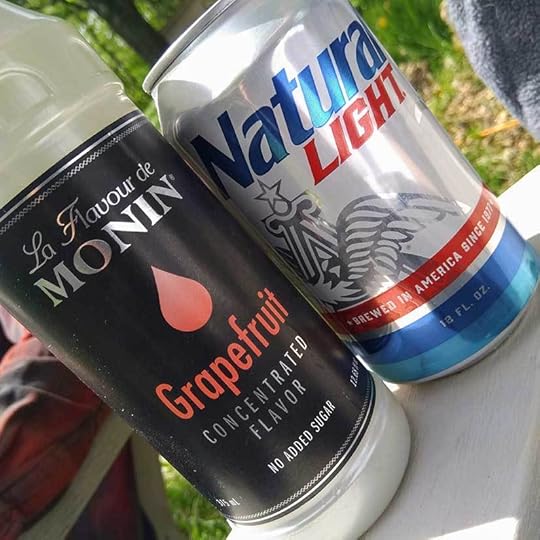
Or, as Wile E. Dog would tell you: make an old dirty leather glove into the world’s best toy. Stay safe and healthy, everyone!

May 19, 2020
Tempting Hymn is Free!
I’ve made Tempting Hymn completely free on Amazon for the first time ever! Giveaway lasts from May 19th to 23rd only. Don’t miss it because this may be the only time I do this before the next book arrives.
Jonas Vanderburg needs Rosa Ramos’s help to rebuild both his health and his life. But Rosa is scared to pin her future on the promises of yet another American. Leaving hospital together is not the biggest challenge for these two people from different faiths, countries, and generations: the missionary mafia that controls colonial Philippine society may never bless their union.
This is a steamy, historical, and cross-cultural marriage-of-convenience novella. More content guidance can be found here.
Praise for Tempting Hymn, a novella in the Sugar Sun series:
“Reading this book feels like a spoon gliding through a custard dessert.” (Phebe on Goodreads)
“Tempting Hymn manages to give adequate breathing room to the harsh historical realities of American colonial rule in the Philippines, while delivering a romance that is sweet, realistic and – above all – emotional….Hallock doesn’t pull any punches in Tempting Hymn, with either the romance or the historical detail. She does her setting and her characters justice, delivering a story that is raw and unflinching, but never too dark, because it has an engaging and touching romance at its core. [And] all the sex scenes here are insanely hot, just like in Under a Sugar Sun.” (Dani St. Clair, Romancing the Social Sciences)
“This novella does a hell of a lot of work between the lines. It’s actually breathtaking.” (Kat at BookThingo, posted on Twitter)
“The pairing here is American man/Filipino woman and that is a tricky, sensitive trope…but it’s handled with deft and care. And dignity.” (Mina V. Esguerra, author of Iris After the Incident, reviewed on Facebook)
“…the first love scene between Jonas and Rosa is a master class.” (Bianca Mori, author of the Takedown trilogy, reviewed on Goodreads)
March 27, 2020
My So-Called #QuarantineLife
I am about to enter a term of online teaching, turning me into a first-year teacher all over again. At the same time, though, I have been doing intense research into the background of my character Liddy, heroine of Sugar Communion. (You can keep up with my reading progress on Goodreads.) As a doctor (or “hen medic” as they were called disparagingly), Liddy is a woman of science. She is a fern instead of a flower, a point of pride for a practical and methodical heroine. After all, it is the logarithmic spiral of a fiddlehead in which one finds the unity of beauty and mathematics. This is the same spiral of the Nautilus pompilius, a rich species of mollusk in the waters of the Tañon Strait off the coast of Bais—the shell-hunting ground of none other than Father Andrés Gabiana? Ah yes, the game is afoot.
But the real world intrudes in on my thoughts too, and I cannot help but see the historical parallels. In the Sugar Sun series, I have spent a lot of time writing about historical epidemics, like the 1902 cholera outbreak in the Philippines. Under the Sugar Sun begins with a scene of ham-handed American attempts to limit the spread of disease. Though cholera is passed by a bacterium not a virus, the type of stay-at-home/shelter-in-place self-quarantine now in place for coronavirus would have worked better for the Filipinos than the activist (and sometimes racist) policies applied by imperialist doctors. None of this is quite #quarantineandchill material, but there is something to be said for finding the happily-ever-after in times like these. Tempting Hymn is the story of a survivor of that epidemic who falls for a nurse. (She is a double heroine—thank you, medical professionals!)
 Cholera has long been a sideshow of war. For the Americans in Manila, it was a challenge to modernity and “benevolent assimilation.” Also, silly naval surgeons. Wile E. Dog takes her livestock guarding seriously, even if I am the only stock she is guarding.
Cholera has long been a sideshow of war. For the Americans in Manila, it was a challenge to modernity and “benevolent assimilation.” Also, silly naval surgeons. Wile E. Dog takes her livestock guarding seriously, even if I am the only stock she is guarding.
November 29, 2019
Waiting in line on #BlackFriday?
Hey you. Yeah, you! Are you waiting in line outside a big box store on #blackfriday? Need something to read while you wait? Check out the Sugar Sun saga…

Read about all the books here. They are interconnected stories that can be read in any order, but if you have an order fetish—and no one here judges you—start with Under the Sugar Sun.
Not sure it’s for you? Check out my content guidance here. Here’s wishing you a history ever after!
November 9, 2019
The 2019 Holiday Season
Calling all Granite Staters! I will be answering questions and selling signed books all over the southern New Hampshire area this holiday season with my partners-in-print, the Weare Area Writers Group:
November 14th (Thursday) from 6:30 to 8:00: An Evening with the Weare Area Writers Guild at the Dunbarton (NH) Public Library, 1004 School St, Dunbarton Center, New Hampshire 03046
November 16th (Saturday) and 17th (Sunday) from 9:00 am to 1:00 pm: 40th Annual Bow Craft Fair at the Bow High School, 55 Falcon Way, Bow, NH 03304
November 23rd (Saturday) from 9:00 am to 4:00 pm: Christmas at the Brook at the Brookside Congregational Church, 2013 Elm St, Manchester, New Hampshire 03104
November 24th (Sunday) from 11:00 am to 4:00 pm: Holiday Craft Fair at the Steeplegate Mall, 270 Loudon Rd, Concord, New Hampshire 03301
December 7th (Saturday) from 9:00 am to 2:00 pm: 30th Annual Beaver Meadow School Craft Fair and Bake Sale at Beaver Meadow School, 40 Sewalls Falls Rd, Concord, New Hampshire 03301
What I love best about working these fairs is the chance to talk to readers about what stories they love the best. Check out my fellow authors’ books as well on our group’s website. We have something for everyone’s holiday gift list!
August 27, 2019
A Sugar Communion Research Report
I drove two hours to attend Latin Mass and, predictably, understood not a word. The church was not struck by lightning, though, so I am counting it a win.
Let’s start at the beginning. People say write what you know, and it is good advice…that I do not follow very often. Okay, well sometimes I do: I’ve written two teacher characters so far. My heroines in past and future books hail from Boston (near where I currently live); Fairmont, West Virginia, where my mother moved in high school and the home of my favorite pepperoni rolls; and Columbus, Ohio, where I grew up. I love inserting sports into my historical novels because I am a football and volleyball coach who grew up playing softball and dated a baseball player in high school. Even the hymns used in my novella are favorites from daily singing at the Episcopal school where I teach.
But I have nothing in common with a Roman Catholic priest in 1900. I have written men before, though not celibate men who spent their entire young adult life in the seminary listening to lectures in Latin. When trying something completely different, research matters. I want to write Andres Gabiana as authentically, respectfully, and convincingly as possible.
Where to start? I read. And I read. And I read. You can follow my progress on Goodreads, if you like. What follows is not going to give you any spoilers about the upcoming novel, Sugar Communion. It is more like a stream-of-consciousness book report (which I would admittedly never accept from my own students). Here goes:
I’ve read twenty-two priest and nun memoirs so far. I’ve read three written by priests who, after struggling with celibacy, rededicated themselves to their vows and remained active priests. I have read three written by children of priests and nuns. I have read one by a man who came close to entering the seminary—he lived with religious orders and went on retreats—but ultimately decided against it. Mostly, though, I have targeted memoirs (fifteen of them) written by Roman Catholic priests who left the Church. And, like most of the other hundred thousand American priests who have left, they did so in order to take part in consensual, adult relationships. I really cannot emphasize these last three words enough: Consensual. Adult. Relationships. If marriage is a sacrament and a human right, and the Church says it is, then these priests left to exercise that right.
Sadly, consensual adult relationships with priests are not the average Bostonian’s first thought, but here’s the problem: the priests who sexually abused children in this diocese hid inside the Church. They did not leave it. And that has cost the bishops: nineteen American dioceses have been bankrupted by $3 billion dollars in court judgments, according to the National Catholic Reporter, and all because the Church refused to listen to victims and victims’ families, and instead reassigned these criminals to new parishes instead of turning them into the authorities. Pedophile priests are a small—and incredibly destructive—fraction of those who have broken their celibacy vows. Celibacy does not cause pedophilia. Institutionally, though, it can create the conditions that allow it to thrive, if the seed is already planted: a flawed selection process for priests, sexually immature men in positions of power, a culture of secrecy and shame around sex, and possibly a celibate’s lack of a parental impulse to protect children.
In order to separate my story as far as I can from this pattern, my heroine is a few years older than my priest (both are in their 30s); she is a professional (medical doctor) in her own right; and she is not a member of his parish. Andres is also a good man and a good priest.
He is a good priest, I swear, even by the teachings of the Church itself. Did you know that throughout the first eleven hundred years of Christian history, the leadership—including popes, bishops, and parish priests—could legally wed and celebrate the faith as married men? (I did not know this, either, not until I read two academic treatments from experts A. W. Richard Sipe and William E. Phipps, which are the basis of most of the historical information to follow.) The Jewish tradition celebrated married love and required it of priests and rabbis. Not only was Jesus a Galilean Jew, but his role could be best described as an early rabbi (teacher and scholar). There is evidence that Jesus himself may have been married (and maybe widowed) by the time of his ministry. We know Peter was married. Paul was widowed. Moreover, in the early Jesus Movement, women played significant roles in ministry, church leadership, and funding.
So where did Catholic clerical celibacy and patriarchy come from? Pre-Christian Greek philosophers like Plato and Aristotle. If you didn’t know, these guys were pretty big misogynists, as were most Athenian men. It is from their teachings that early Christian saints decided that male genitals and the whole of women were created by Satan. A female was a defective male, Saint Thomas Aquinas said, quoting Aristotle.
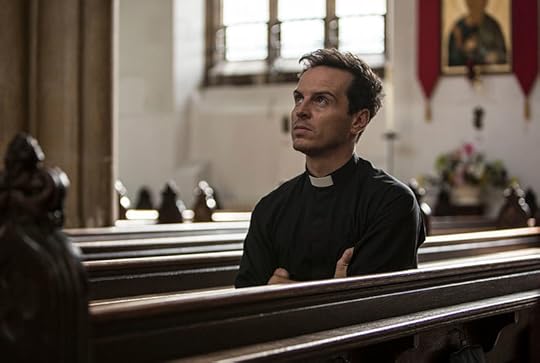 One of my favorite non-celibate priests on television: Andrew Scott plays the priest on the second season of Fleabag. Photo by Luke Varley / BBC / Two Brothers and found on The Guardian.
One of my favorite non-celibate priests on television: Andrew Scott plays the priest on the second season of Fleabag. Photo by Luke Varley / BBC / Two Brothers and found on The Guardian.Even worse, once clerical celibacy was required—not until 1139, mind—it inaugurated the most corrupt period in the Church’s history. Marriage was eschewed as foul, while concubinage, pedophilia, and rape were only given mild cautions that were often ignored. Everyday churchgoers needed protection from ravenous clergy that hunted their wives and daughters. Those few priests who wanted to live moral lives by marrying their spouses found themselves excommunicated and their wives enslaved. Schisms and war erupted. It was a nasty time of division and violence, and it was overseen by the men who brought the Church celibacy.
Today Catholic clergy do not even agree upon the definition of celibacy, let alone practice it consistently. At any one time, Sipe says, only about half the clergy in the United States are celibate. What I have learned from the memoirs I have read is that most priests were not given any training at how to be celibate while they were in seminary, other than a few lectures on Eve’s temptations and the corruption of the earthly sphere. They might also be taught the official Catholic teaching on homosexuality as a “disordered” behavior, despite recent studies that have estimated over half of American priests today would identify themselves as gay or bisexual if they were free to do so. The person who first encouraged me to try a Latin Mass is a practicing Catholic who currently lives with his common-law husband, the love of his life, in Arizona. Had this friend been free to be a married gay priest, he would have been one of the very best. Good people of all genders are lost to the priesthood because, for reasons that have nothing to do with their morals and leadership qualities, they are not allowed to apply.
Sexual liaisons are not the only relationships that seminaries restricted, I have learned. In the nineteenth and early twentieth centuries, seminaries did not want their charges to even have close friendships. The instructors monitored who walked with whom between buildings like they were overseeing cotillion dance cards. Nor was a seminarian allowed to remain in close contact with his own family. Trips home—even for weddings and funerals—were very limited. The future priest was the property of the Church and not the other way around. Even after ordaination, the vow of celibacy allows this control to continue for a lifetime. Bachelor priests are easier to move without notice, and they have no widows or heirs to claim Church property. Not surprisingly, then, the theme that came out strongest in all the memoirs is loneliness.
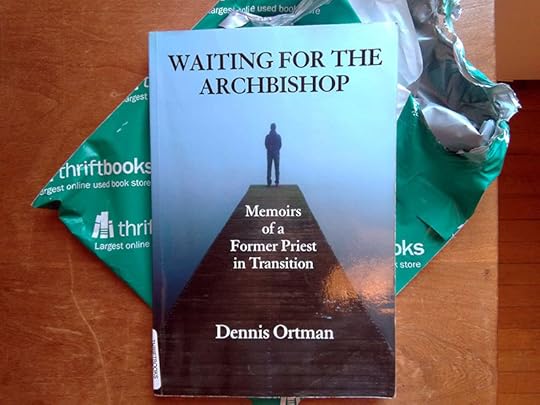 One of the most introspective memoirs I’ve read is Waiting for the Archbishop by Dennis Ortman, probably because the priest later became a psychiatrist and he’s willing to really dig deep.
One of the most introspective memoirs I’ve read is Waiting for the Archbishop by Dennis Ortman, probably because the priest later became a psychiatrist and he’s willing to really dig deep.By immersing myself in these memoirs, I have been able to live, albeit briefly, in the culture that will shape Andres Gabiana. I took extensive notes, and I even bought a scanner to enter them! Most of what I learned will never make it to the fiction page, but it still helps to set the scene in my head.
Most of the memoirs on my reading list took place during the 1940s-1980s, mostly in the United States and Ireland but also one in rural Brazil. I do not read Spanish or Filipino, which limits my Philippines-based sources. However, many of the orders operating in the Philippines were European-based, and their rules applied internationally. The Church is also a hierarchical organization following its own canons (code of law) applied throughout every diocese.
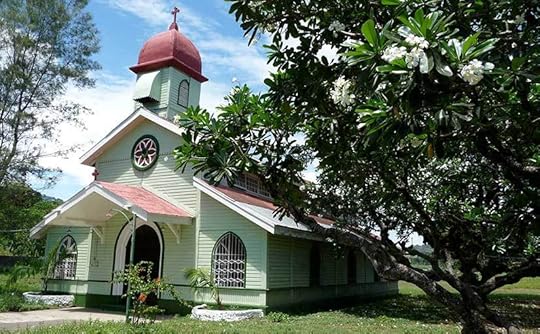 The Mojon Chapel at the Central Azucarera de Bais that became my vision of San Honorato on Hacienda Altarejos.
The Mojon Chapel at the Central Azucarera de Bais that became my vision of San Honorato on Hacienda Altarejos.The Brazilian account exposed one flawed assumption from my previous books. In the provinces of predominantly Catholic countries in the early twentieth century, priests would have been in short supply. No curate would have had the luxury of ministering at one tiny chapel at Hacienda Altarejos full-time. Poor Andres. His job just got a lot harder. You’ll see.
Research itself will only take you so far, though. Some things you have to witness. For example, even if you are Catholic, forget (almost) everything you know about mass. The Latin Rite (pre-1962) is not just in Latin, a language that most laypeople do not understand, but also the priest keeps his back to the congregation the vast majority of the time. Half the time he whispers. The only chance for participation is at communion, which is still not a verbal exchange. I had to see the whole thing in person to understand it, so this Monday morning I went to Latin Mass.

On the face of it, the ritual seems designed to be incomprehensible. I barely saw the Host and never saw the priest consume the sacramental bread and wine. It was like watching a cashier make change from across the room. In a court of law, I could not testify that he actually did it. And, to be honest, that confused me more than the silence. It’s not great showmanship—or is it? Maybe what appeals to people in the service is the mystery: “a religious truth known or understood only by divine revelation.” Awe and enigma have fueled religions from the beginning.
I was most impressed by the server, or altar boy. (It does not have to be a boy, by the way. It can be a layman, a subdeacon, deacon, or another priest. Needless to say, he does have to be a male.) I would say the boy was about the age of my students, going into ninth grade. He had to know more than just when to ring the bell: he had to answer for the congregation since we never spoke. This meant he had to know a lot of Latin, and he had to say it clearly. In fact, I found it easier to understand his elocution than the priest’s because, proudly, he sorta shouted. He did not go to school for eight or twelve years to learn how to manage this mass; he learned his part on his own time. He probably takes Latin at the local Catholic school, but still.
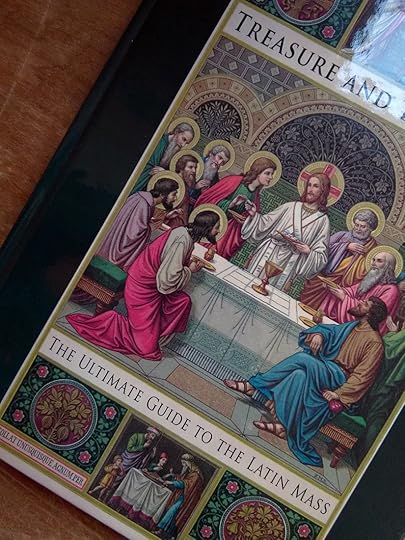 Treasure and Tradition is a clear, beautifully illustrated, and complete introduction to Latin Mass. I recommend reading it cover-to-cover before you go the first time.
Treasure and Tradition is a clear, beautifully illustrated, and complete introduction to Latin Mass. I recommend reading it cover-to-cover before you go the first time.I do not think Roman Catholicism would not have survived as the largest denomination of Christianity these past fifty years if it had stayed so inscrutable, but the Latin Rite does have its attractions—especially for the priest, I imagine. He is also more remote, powerful, and enigmatic. This had to be, at least partly, the draw of a vocation. As all the memoirs made clear, the whole family took on an elevated status in the parish once they had a son in the seminary. (I do not know if this last part is still true because traditional geographic parishes are breaking down in favor of “personal parishes,” or parishes based on nationality, language, or other specializations. The church I went to was a personal parish centered around the Latin Rite, for example.)
I never spoke to the priest about any of my reactions. I never spoke to him at all. He did not seem particularly stern or unapproachable—he was younger than me, probably in his late 20s or early 30s, and he sported a well-trimmed beard. I did not talk to him because he wasn’t standing at the back of the Church shaking hands as people left. Maybe he greets the parish after High Mass on Sundays? I will go sometime to find out, but I am still not sure what I would ask him. I could ask why he chose to be a part of a religious order dedicated to the Latin Rite, the Priestly Fraternity of St. Peter, but that seems like more than a two-minute conversation.
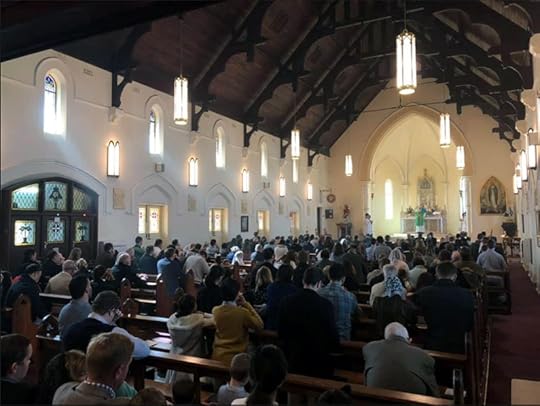 Can you see what he’s doing? Yeah, me neither. Creative commons photo courtesy of Luke Moloney on Wikimedia Commons.
Can you see what he’s doing? Yeah, me neither. Creative commons photo courtesy of Luke Moloney on Wikimedia Commons.There’s one place for sure that the mass-goer can talk to the priest: in confession before the service begins. In the memoirs I read, though, most priests disliked confession. It is not the voyeuristic extravaganza you might expect. It’s everyday stuff at best (cursing, gossip, impure thoughts); and it’s troubling at worst (domestic violence) without clear ways to intercede and provide help without violating the seal. Crime dramas centered around confessed murders rarely happen, despite each priest hearing dozens if not hundreds of confessions a week for their entire careers. (Not that anyone wants a murderer confessing to them, of course.) Still, I have a lot of ideas for fun conversations in the confessional. I mean, can you imagine Allegra’s confessions? It might be enough to send a priest running.
Actually, one theme that came from both the academic books and the memoirs is that confession can mire a priest in the muddy sludge of the material world—lust, greed, corruption—for which the seminary’s tight rules do not prepare him. Often he is ordained before he truly understands what he is agreeing to. He goes from not talking about sex at all to parishioners asking questions about sex (e.g. “Is oral sex with my husband a sin?”). At the time that celibacy became a discipline in the Roman Catholic Church, most priests would have lived about ten to fifteen years total after their ordination. Now they live fifty or more. Statistically, the hardest year for priests is the thirteenth anniversary of their ordination, and by this point many priests have reached a crisis.
In the time that Andres will be a priest, it was almost impossible to leave the clerical office. Though it is easier now to be laicized, or “reduced” to the non-clerical state, it can still take years, or even decades, because the Church is very good at burying paperwork. Meanwhile, they are told to stay far, far away from their old dioceses and all their old friends, some of whom have cut them off anyway. Loneliness can beget more loneliness. And despite what you read in the press, there is no such thing as an ex-priest in the Roman Catholic Church. A priest is a priest forever, even if no longer able to receive confessions, which is done on behalf of the bishop. A laicized priest can still administer some sacraments, like the Eucharist and Extreme Unction, but he can no longer serve as deacon (the position he had before ordination). In other words, their status is…complicated.
Let me thank all the priests (and children of priests) who wrote their memoirs. They have been willing to share their most personal thoughts with me, a stranger. It has been a summer of learning. If you have comments on this book report, please join my Facebook group, History Ever After, and post them there. The real test, dear reader, will be writing Sugar Communion, and there my work is just beginning.
 If you want to keep tabs on what I am reading, check out my list on Goodreads.
If you want to keep tabs on what I am reading, check out my list on Goodreads.
Sugar Sun Series Extras
- Jennifer Hallock's profile
- 38 followers




